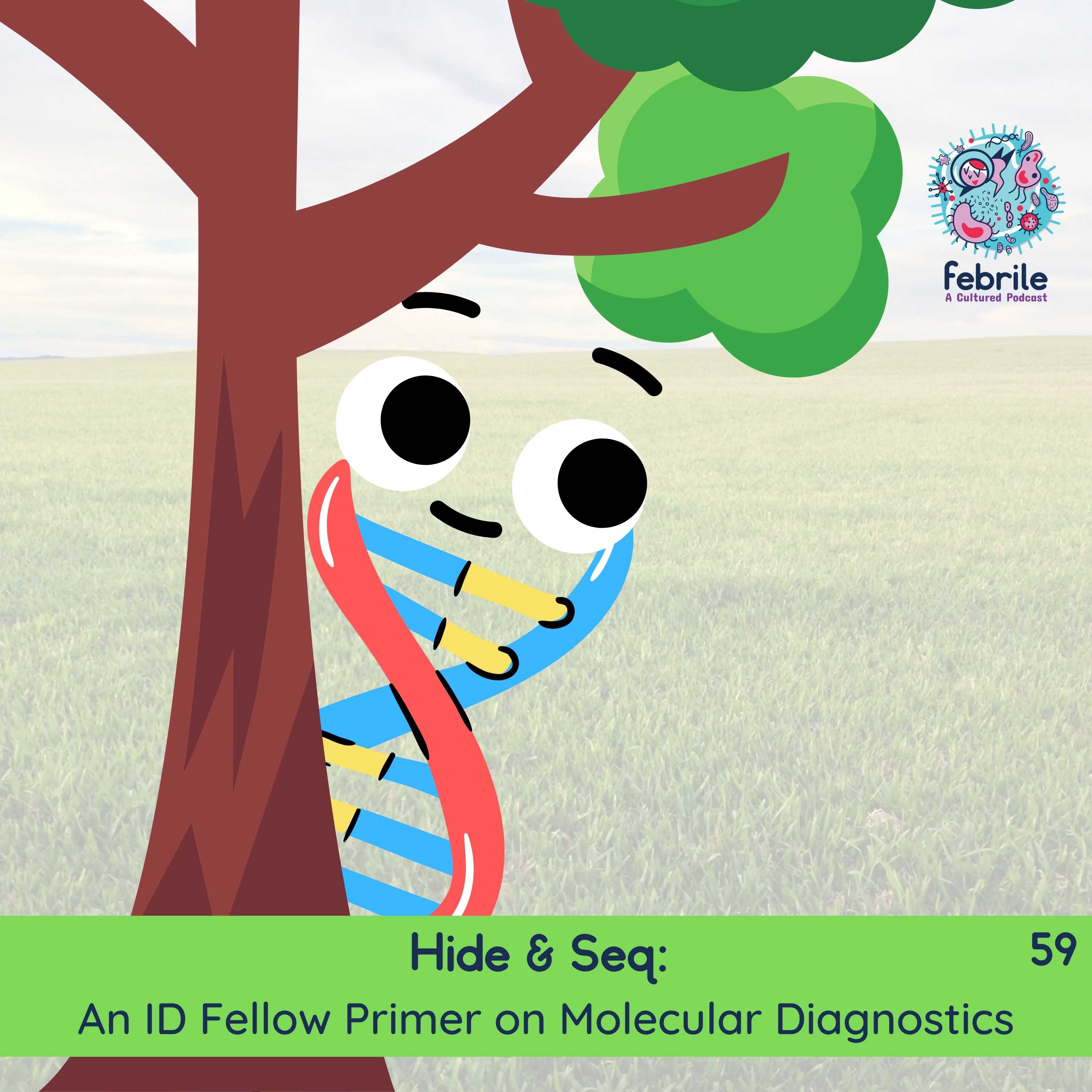Table of Contents
Credits
Hosts: Pratik Patel, Sara Dong
Guests: Robin Patel, Kevin Messacar
Writing: Pratik Patel, Sara Dong
Producing/Editing/Cover Art/Infographics: Sara Dong
Our Guests
Guest Co-Host
Pratik “Tik” Patel, MD

Dr. Tik Patel is a 2nd year pediatric ID fellow at Emory University and Children’s Healthcare of Atlanta. He also completed a pediatric hematology/oncology fellowship at the same institution. He wishes to leverage his training in both fields to advance the infectious disease care of immunocompromised children with a focus on those undergoing treatment of cancer and hematopoietic stem cell transplant. He has a burgeoning research interest in introduction and implementation of novel diagnostics for improved stewardship and clinical care.
Guest Consultant
Kevin Messacar, MD, PhD

Kevin Messacar, MD PhD, is an Associate Professor of Pediatrics at the University of Colorado School of Medicine. He is an attending pediatric hospitalist and infectious disease consultant at Children’s Hospital Colorado. Dr. Messacar obtained a BS with honors in biochemistry at the University of Michigan, MD at the University of Michigan Medical School, and PhD in Clinical Investigations at the University of Colorado Graduate School. Dr. Messacar did his pediatric residency and infectious disease fellowship training at the University of Colorado where he received numerous teaching awards.
Dr. Messacar’s research seeks to improve diagnostic tests and surveillance for central nervous system infections with a focus on enteroviruses and other emerging infectious diseases. He is interested in the process of selecting, implementing, and evaluating newly rapid diagnostic technologies using concepts of diagnostic and antimicrobial stewardship. In 2014, Dr. Messacar received the Colorado Department of Public Health and Environment Astute Physician Award for recognition of the association between acute flaccid myelitis and enterovirus D68 in Colorado children, and he is currently a member of the CDC Acute Flaccid Myelitis Task Force. In 2021, he received the Young Investigator Award from the Pediatric Infectious Disease Society for significant contributions to the field in the first 7 years of his career. He is currently the principal investigator of a multicenter pandemic preparedness clinical research study with the NIAID Vaccine Research Center called PREMISE, Pandemic REsponse REpository: Microbial and Immunologic Surveillance and Epidemiology.
Guest Consultant
Robin Patel, MD

Robin Patel is the Elizabeth P. and Robert E. Allen Professor of Individualized Medicine and the Director of the Infectious Diseases Research Laboratory, Co-Director of the Clinical Bacteriology Laboratory, Vice Chair of Education in the Department of Laboratory Medicine and Pathology, and former Chair of the Division of Clinical Microbiology, at the Mayo Clinic.
Since the beginning of her tenure at the Mayo Clinic, Dr. Patel has focused her research on bacterial infections. Her work focuses on three major areas: (1) improvement of next-generation diagnostic techniques, (2) understanding the inherent biology of periprosthetic infection, and (3) understanding antibiotic resistance through a clinical lens. She has published over 540 peer-reviewed publications and is supported by the National Institutes of Health and the Centers for Disease Control and Prevention. She is the Director of the Laboratory Center of the Antibacterial Resistance Leadership Group of the National Institutes of Health.
Dr. Patel received an undergraduate degree in Chemistry from Princeton University, where she graduated magna cum laude. From there, she obtained a medical degree from McGill University. Afterwards, Dr. Patel completed Internal Medicine Residency and Fellowships in Medical Microbiology and Infectious Diseases at the Mayo Clinic. Since then, she has been involved in setting standards for diagnostic and clinical care of bacterial infections, as evidenced by the (select) positions she has held or holds within the American Society for Microbiology (President), American Board of Pathology (Microbiology Test Writing Committee Member), Clinical and Laboratory Standards Institute (Subcommittee on Antimicrobial Susceptibility Testing Voting Member), National Institutes of Allergy and Infectious Diseases (Council Member), National Board of Medical Examiners (Microbiology/Immunology Test Material Development Committee Chair), Journal of Clinical Microbiology (Associate Editor), and Clinical Infectious Diseases (Associate Editor).
In addition, Dr. Patel’s continued commitment to mentorship can be translated into a long list of trainees from around the world; she had dedicated hours of teaching to train the next generation of clinical and research laboratory scientists.
More information can be found at: https://journals.asm.org/doi/full/10.1128/JCM.01259-20.
Consult Notes
We started with the basics. What is DNA? What is RNA? How do these relate to diagnostics of infectious diseases?
- DNA = deoxyribonucleic acid. We’ve learned about DNA as the hereditary material in humans, but it is also present in bacteria, fungi, parasites, and DNA viruses. DNA makes a great target for detecting organisms because the DNA of each microbial species is fairly unique
- RNA = ribonucleic acid. This is what is transcribed from DNA in DNA containing organisms, but we also have certain organisms that have an RNA genome and no DNA (such as certain respiratory viruses). So it’s important that we can use RNA as a target for detection as well
What is PCR?
- PCR = polymerase chain reaction
- Described back in the 1980s initially
- A technique in molecular biology for amplifying small segments of DNA
- Double stranded DNA is denatured first
- Technique then involves the use of primers – typically a pair of primers that anneal and then synthesize the DNA between them using an enzyme called DNA polymerase
- This cycle is repeated over and over again >> so whatever region of DNA is being targeted is amplified exponentially
- Traditionally you would detect that amplified material with gels or Southern blots, but today we’re commonly using probes. Probes are hybridizing at the same time that the PCR is taking place so that we know we’ve amplified a very specific product, which is important for diagnosis of infectious diseases
Tik asked about different types of PCR “reactions”, such as qRT-PCR (quantitative real-time reverse transcriptase PCR), transcription-mediated amplification (TMA), nucleic acid amplification test (NAAT)
- Robin explained that there are many ways of amplifying segments of DNA or RNA, and PCR as she described is like a classic or original way of doing so
- Real-time PCR is based on generation of amplified target which is measured in “real time” with fluorescent probes
- Reverse transcriptase PCR is a variation in which the starting material is RNA that must first be converted to DNA
- There are many variations on how to do PCR that differ with the starting material and work on different principles – but the same idea is there that you’re amplifying a specific gene
What is a cycle threshold?
- When you’re carrying out PCR, you’re amplifying exponentially whatever gene you’re targeting. You have probes that are hybridizing or you can use specific stains that stain your amplified double stranded DNA, but you’re getting a signal from whatever is giving you the detection
- That signal will increase over time as you amplify your target
- At some point, that signal will cross over whatever threshold it is that you are defining as a positive result
- So the cycle threshold refers to the number of cycles in a PCR assay needed to amplify until you reach that “detectable” threshold
- CT values can thus indicate the relative amount/level in a specimen
- A low CT means that you have a gene that you’re targeting that’s present in higher abundance
- A high CT reflectsthat you have lower amount
- *This is a general principle though*
- People have tried to take cycle threshold values and transition what is a qualitative assay into a quantitative assay in ID – but its very important to note that clinical application of the non-standardized CT value is uncertain and not validated to guide management (such as in SARS-CoV2)
- We do have quantitative assays (for example when we measure HIV viral load), but these are specifically validated to be quantitative and include standards in the assay that tell you when you get a certain quantity, that is the correct quantity. So there are quality control measures incorporated into those assays
Kevin highlighted a few examples of specific tests that we use that are PCR based. This list is NOT comprehensive, but a few examples:
- Traditionally we have used a very pathogen specific approach to identify if an organism is present or not (which required clinical suspicion). Some examples include:
- Influenza PCR
- HSV PCR
- Mycoplasma PCR
- Group A Strep
- Gonorrhea/chlamydia NAAT
- Kingella kingae or Lyme PCR from joint fluid
- And many more!
- Kevin explained how there has been a bit of a transition in molecular testing for clinical infectious diseases in the past decade or so, which leaned more towards a syndromic approach. This is often combining multiple PCR tests in one platform known as a syndromic panel (typically multiplex PCR, so semi nested PCR that can contain multiple targets which can include viruses, bacteria, parasites, fungi; can be DNA and/or RNA targets)
- Many are familiar with the meningitis/encephalitis infection panels, but others exist for bloodstream infections, respiratory/pneumonia infection, GI illnesses
Next we moved to broad-range PCR
- We had previously been discussing specific assays that target a single organism, but another approach is to go after a target that is present in every organism
- Broad-range bacterial PCR testing is based on 16S rRNA
- Think back to microbiology and genetics, all bacteria/prokaryotes have small and large subunit for their ribosomes which are responsible for making their proteins. The predominant rRNA genes for the small and large subunits are called 16S and 23S respectively
- 16S is present in all bacteria, so you can use this as a general indicator that there are bacteria there. PCR primers can be used to amplify a fragment of the 16S rRNA gene from any bacterium that is present in the sample
- 16S has areas of “conserved sequences” and then variable regions which are genus and species specific. The sequence data can be compared to identify which bacterial species were are looking at
- Broad-range fungal PCR testing
- Fungi have larger subunits so the small subunit rRNA gene is 18S and large subunit is 28S. These follow the same pathway
- Broad-range mycobacterial PCR testing
- Robin explained that Mycobacteria are bacteria, so can still use 16S rRNA gene PCR sequencing assay. Depending on how the assay is designed, you might be targeting different areas of the 16S rRNA gene to better separate different group of bacteria though
- So once the relevant genes are amplified by PCR, how does the identification happen?
- Robin explained Sanger sequencing, which is the most straightforward. You have bidirectional sequencing (from both forward and reverse primers), which can overlap and provide same answer twice in both directions
- The concatenated sequence is then run against a database, where you can have some variability
- You might use a pre-constructed database or
- Might use a public database such as NCBI, which is not completely curated but is more comprehensive
- Robin explained that sometimes all related spp are in the analysis and in the database, but sometimes they are not. Her example was how Brucella spp have pretty much the same sequence
- In the US, University of Washington-Seattle Molecular Microbiology Diagnostics Lab and Mayo Clinic lab do this testing
What are some possible clinical scenarios where there is data or experience with broad-range PCR?
- Kevin summarized some caveats to remember from a clinical research standpoint, when reading retrospective observational data sets (which tend to include very heterogenous populations and oftentimes testing is sent at various time point in the course of disease)
- Typically a high yield scenario would include patients where you identify organisms on staining or have histopathologic response suggesting infection but cannot get an identification by routine microbiological techniques (such as diagnostically challenging organism to grow, antimicrobial pre-treatment)
- Robin highlighted culture negative endocarditis and the use of PCR sequencing on valve tissue
- Some literature on broad-range PCR sequencing for ID:
- Pediatric experience from Boston Childrens Hospital: Naureckas Li C, Nakamura MM. Utility of Broad-Range PCR Sequencing for Infectious Diseases Clinical Decision Making: a Pediatric Center Experience. J Clin Microbiol. 2022;60(5):e0243721. doi:10.1128/jcm.02437-21
- Pediatric experience from Nationwide Childrens Hospital: Lucas EJ, Leber A, Ardura MI. Broad-range PCR Application in a Large Academic Pediatric Center: Clinical Value and Challenges in Diagnosis of Infectious Diseases. Pediatr Infect Dis J. 2019;38(8):786-790. doi:10.1097/INF.0000000000002308
- Pediatric experience from Rainbow Babies and Childrens Hospital: Lim PPC, Stempak LM, Malay S, Moore LN, Cherian SSS, Desai AP. Determining the Clinical Utility of 16S rRNA Sequencing in the Management of Culture-Negative Pediatric Infections. Antibiotics (Basel). 2022;11(2):159. Published 2022 Jan 26. doi:10.3390/antibiotics11020159
- Mayo Clinic experience: Fida M, Khalil S, Abu Saleh O, et al. Diagnostic Value of 16S Ribosomal RNA Gene Polymerase Chain Reaction/Sanger Sequencing in Clinical Practice. Clin Infect Dis. 2021;73(6):961-968. doi:10.1093/cid/ciab167
- Adult UCSF experience: Kerkhoff AD, Rutishauser RL, Miller S, Babik JM. Clinical Utility of Universal Broad-Range Polymerase Chain Reaction Amplicon Sequencing for Pathogen Identification: A Retrospective Cohort Study. Clin Infect Dis. 2020;71(6):1554-1557. doi:10.1093/cid/ciz1245
- Adult experience from Ireland: Teoh T, McNamara R, Powell J, O’Connell NH, Dunne CP. A retrospective observational study of the impact of 16s and 18s ribosomal RNA PCR on antimicrobial treatment over seven years: A tertiary hospital experience. PLoS One. 2021;16(10):e0258552. Published 2021 Oct 12. doi:10.1371/journal.pone.0258552
- Experience from UK microbiology lab network: Aggarwal D, Kanitkar T, Narouz M, Azadian BS, Moore LSP, Mughal N. Clinical utility and cost-effectiveness of bacterial 16S rRNA and targeted PCR based diagnostic testing in a UK microbiology laboratory network. Sci Rep. 2020;10(1):7965. Published 2020 May 14. doi:10.1038/s41598-020-64739-1
- Robin mentioned this paper which looked at 16S rRNA gene PCR sequencing assay applied to 2,146 normally sterile tissue and body fluid samples in routine clinical practice. They have an algorithm where they run a PCR assay first, get a CT value from that PCR assay. If the CT value is low, they run Sanger sequencing. If CT is medium high, they go to next generation sequencing because their validation data suggests Sanger sequencing is unlikely to give us a definitive answer. If the CT value is high, they know sequencing by and large doesn’t give us a useful results, so they report as negative
- They found that adding this NGS to just the Sanger sequencing approach increased positive rate by 87%
- Flurin L, Wolf M, Mutchler M, Daniels M, Wengenack N, Patel R. Targeted Metagenomic Sequencing-Based Approach Applied to 2,146 Tissue and Body Fluid Samples in Routine Clinical Practice [published online ahead of print, 2022 Apr 1]. Clin Infect Dis. 2022;ciac247. doi:10.1093/cid/ciac247
- Robin also mentioned this paper where they compared 16S rRNA gene PCR sequencing or targeted metagenomic sequencing based approach to shotgun approach on sonication fluid.
Next we unpacked metagenomic next-generation sequencing. We’ll include some reminders about the prior DNA sequencing technology as well
- Sanger sequencing is considered the “first generation” of DNA sequencing. This is also referred to as traditional or conventional sequencing, as Robin mentioned on the show
- This determines the sequence of large DNA fragments by collecting and aligning different products polymerized along the DNA template (each nucleotide is tagged, usually by fluorescent tags now rather than radioactive markers)
- This is used clinically when the sequence of a specific gene is being tested >> it often cannot provide info on multiple genes at a practical cost or within a reasonable timeframe
- Next-generation sequencing (NGS), sometimes also called high throughput sequencing or deep sequencing
- This sequences multiple DNA fragments in parallel with a much higher speed and amount and lower cost than Sanger. Robin explained that this could best be referred to as “massively parallel sequencing”
- There are several platforms developed
- Robin explained that the term “metagenomic” has been used in various ways, but typically a metagenomic assay is going to involve next generation sequencing
- You can do this in a completely unbiased way where you just sequence everything in a sample >> everything (human genome, bacteria, fungi, parasites, DNA viruses) but RNA viruses
- You could introduce a step where you take RNA and convert to DNA to sequence to detect RNA viruses
- You can do this in a completely unbiased way where you just sequence everything in a sample >> everything (human genome, bacteria, fungi, parasites, DNA viruses) but RNA viruses
- What commercial platforms can clinicians order this sequencing for ID purposes currently?
- Blood: Karius platform
- CSF: UCSF, UW
What are some possible clinical scenarios where there is data or experience with next generation metagenomic sequencing?
Here are some papers related to metagenomic and targeted next-generation sequencing
- For cell-free plasma NGS:
- Endovascular infection: Eichenberger EM, de Vries CR, Ruffin F, et al. Microbial Cell-Free DNA Identifies Etiology of Bloodstream Infections, Persists Longer Than Conventional Blood Cultures, and Its Duration of Detection Is Associated With Metastatic Infection in Patients With Staphylococcus aureus and Gram-Negative Bacteremia. Clin Infect Dis. 2022;74(11):2020-2027. doi:10.1093/cid/ciab742
- Adults with infective endocarditis: Eichenberger EM, Degner N, Scott ER, et al. Microbial Cell-Free DNA Identifies the Causative Pathogen in Infective Endocarditis and Remains Detectable Longer Than Conventional Blood Culture in Patients with Prior Antibiotic Therapy [published online ahead of print, 2022 Jun 10]. Clin Infect Dis. 2022;ciac426. doi:10.1093/cid/ciac426
- Dworsky ZD, Lee B, Ramchandar N, Rungvivatjarus T, Coufal NG, Bradley JS. Impact of Cell-Free Next-Generation Sequencing on Management of Pediatric Complicated Pneumonia. Hosp Pediatr. 2022;12(4):377-384. doi:10.1542/hpeds.2021-006361
- Pediatric study where clinically relevant pathogens causing bacteremia in oncology patients were identified early on cfDNA sequencing: Goggin KP, Gonzalez-Pena V, Inaba Y, et al. Evaluation of Plasma Microbial Cell-Free DNA Sequencing to Predict Bloodstream Infection in Pediatric Patients With Relapsed or Refractory Cancer [published correction appears in JAMA Oncol. 2020 Feb 27;:]. JAMA Oncol. 2020;6(4):552-556. doi:10.1001/jamaoncol.2019.4120
- Adults with febrile neutropenia: Benamu E, Gajurel K, Anderson JN, et al. Plasma Microbial Cell-free DNA Next-generation Sequencing in the Diagnosis and Management of Febrile Neutropenia. Clin Infect Dis. 2022;74(9):1659-1668. doi:10.1093/cid/ciab324
- Niles DT, Wijetunge DSS, Palazzi DL, Singh IR, Revell PA. Plasma Metagenomic Next-Generation Sequencing Assay for Identifying Pathogens: a Retrospective Review of Test Utilization in a Large Children’s Hospital. J Clin Microbiol. 2020;58(11):e00794-20. Published 2020 Oct 21. doi:10.1128/JCM.00794-20
- Wilke J, Ramchandar N, Cannavino C, et al. Clinical application of cell-free next-generation sequencing for infectious diseases at a tertiary children’s hospital. BMC Infect Dis. 2021;21(1):552. Published 2021 Jun 11. doi:10.1186/s12879-021-06292-4
- Karius also provides a summary of clinical data on their website at this page
- For meningitis and encephalitis:
- JPIDS review: Graff K, Dominguez SR, Messacar K. Metagenomic Next-Generation Sequencing for Diagnosis of Pediatric Meningitis and Encephalitis: A Review. J Pediatric Infect Dis Soc. 2021;10(Supplement_4):S78-S87. doi:10.1093/jpids/piab067
- NEJM multicenter prospective study: Wilson MR, Sample HA, Zorn KC, et al. Clinical Metagenomic Sequencing for Diagnosis of Meningitis and Encephalitis. N Engl J Med. 2019;380(24):2327-2340. doi:10.1056/NEJMoa1803396
- Piantadosi A, Mukerji SS, Ye S, et al. Enhanced Virus Detection and Metagenomic Sequencing in Patients with Meningitis and Encephalitis. mBio. 2021;12(4):e0114321. doi:10.1128/mBio.01143-21
- For BAL specimens:
- Gaston DC, Miller HB, Fissel JA, et al. Evaluation of Metagenomic and Targeted Next-Generation Sequencing Workflows for Detection of Respiratory Pathogens from Bronchoalveolar Lavage Fluid Specimens. J Clin Microbiol. 2022;60(7):e0052622. doi:10.1128/jcm.00526-22
- Azar MM, Schlaberg R, Malinis MF, et al. Added Diagnostic Utility of Clinical Metagenomics for the Diagnosis of Pneumonia in Immunocompromised Adults. Chest. 2021;159(4):1356-1371. doi:10.1016/j.chest.2020.11.008
What are limitations of molecular testing as it relates to ID?
- As discussed on the show, it all goes back to basic principles of diagnostic reasoning (and pretest probability). It’s important to understand pathogens you may be suspicious of upfront, especially with syndromic panels. In addition, results must be interpreted in the context of the patient’s presentation
- Detection of nucleic acid or presence of organisms does not always equate to active infection that is causing illness/disease, especially in platforms that use cell-free DNA
- We co-exist with microorganisms on and in our bodies, so these tests can detect background or commensal organisms (Kevin’s example was organisms found in immunocompromised patient populations that may be related to disrupted gut barrier)
- We may also detect organism after the active infectious period is done
- Kevin provided the examples of Cdiff PCR testing and prolonged viral shedding after infection
- In addition, there is a risk of detecting contamination with this high level of sensitivity (that might be from time of sample collection, lab personnel, reagents used for sequencing, etc)
- False negatives can occur with low amounts of organisms or nucleic acid to amplify or suboptimal specimen collection
- It is also important to remember that multiplex PCR panels often have lower sensitivity compared to their respective singleplex tests, such as HSV and Cryptococcal testing with individual PCRs vs. meningitis-encephalitis panels
- Detection of organisms does not give you susceptibility data for bacteria, mycobacteria, or fungi (yet…)
- Finding localized infections from blood or other specimens may not be diagnostic
- Here is a quick read about the human “contaminome” and limitations with high throughput genome sequencing: Simner PJ, Salzberg SL. The Human “Contaminome” and Understanding Infectious Disease. N Engl J Med. 2022;387(10):943-946. doi:10.1056/NEJMcibr2208625
Looking forward
- Robin and Kevin emphasized how this is a great space for ID fellows to get involved with diagnostic stewardship and clinical research!
- They emphasized the need for indication or disease driven data – so not just sending the test at any time, but trying to understand how does a particular platform work for say culture negative endocarditis or periprosthetic joint infection. When is it clinically impactful? Cost effective?
- Robin discussed how maybe one day we hope to be able to sequence deep enough to recapitulate the bacteriums chromosomal genetic elements, plasmids, and so forth to analyze genomic data to phenotype susceptibility prediction!
- Kevin is looking forward to when we might be able to use this testing +/- machine learning to understand or differentiate when something might be an autoimmune response vs pathogen response vs something else
Infographics
Goal
Listeners will be able to understand the benefits and challenges of use of molecular diagnostics for detecting infectious diseases
Learning Objectives
After listening to this episode, listeners will be able to:
- Describe the basic principles of polymerase chain reaction, Sanger sequencing, and next generation sequencing
- Define a cycle threshold
- Discuss the limitations and challenges of molecular diagnostics for infectious diseases
Disclosures
Our guests (Pratik Patel, Kevin Messacar, Robin Patel) as well as Febrile podcast and hosts report no relevant financial disclosures
Citation
Patel, P., Messacar, K., Patel, R., Dong, S. “#59: Hide & Seq: An ID Fellow Primer of Molecular Diagnostics.” Febrile: A Cultured Podcast. https://player.captivate.fm/episode/4fbf54e8-5fbd-4dd0-9e58-3608c8855a66


